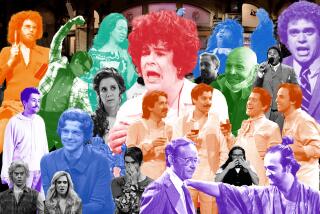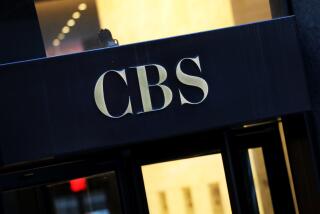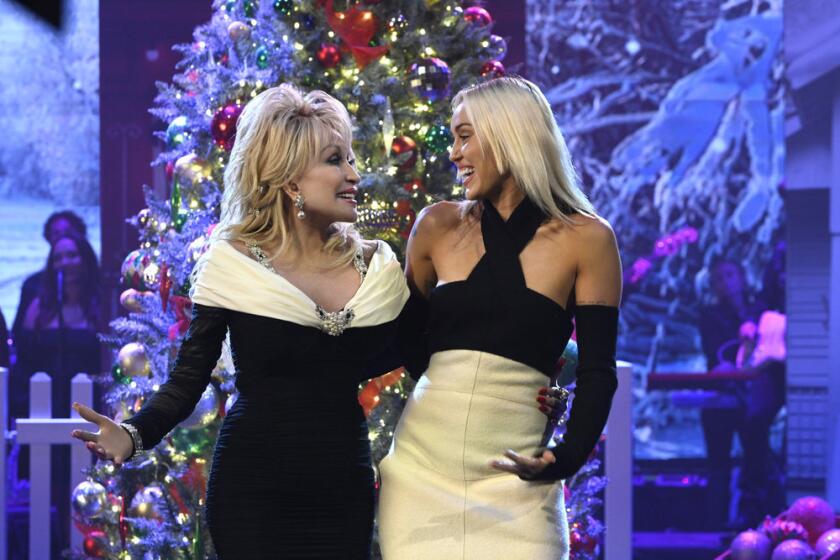Networks’ New Wave of News
The possible future of TV network news was on stark display this week -- at Comedy Central.
Visiting “The Daily Show,” the cable network’s buzz-generating fake newscast, Brian Williams, the newly minted anchor at NBC, joked with the host about the media’s endless fascination with Princess Diana and Julia Roberts’ newborn twins. After the crowd laughed heartily at a few dry one-liners from Williams, host Jon Stewart wondered aloud, “Why do I think you’d be better at this job than I am?”
That might not be such a far-fetched proposition.
With Williams taking over tonight for Tom Brokaw, 64, on “NBC Nightly News,” and Dan Rather’s announcement last week that he is leaving “CBS Evening News” in March, the often-staid broadcast news divisions appear ready to embrace change.
Everything seems to be on the table. Networks might push newscasts to later in the evening to adapt to family schedules and commuters. Anchors such as Williams will increasingly turn up on early morning shows and Internet chat rooms to gain more exposure, and broadcast executives hope, viewers. And yes, they will make frequent guest appearances on entertainment programs like “The Daily Show,” which has become a proxy newscast for many young viewers.
“When Brokaw and Rather and [ABC anchor Peter] Jennings were hired, the purpose of the evening newscast was to give viewers what the gatekeepers thought was important, with a stamp of approval from seasoned professionals,” said Marty Kaplan, associate dean of USC’s Annenberg School for Communication.
“Now, I’m not sure the audience believes in the legitimacy of the gatekeepers or even cares what they have to say.... I don’t think the new anchors will be inhabiting the same set of assumptions as before.”
Entertainment values -- employed fully by Fox News Channel in its successful decade-long battle against CNN -- are becoming paramount.
Jonathan Klein, the former Internet executive named as CNN chief last month, warned against an overabundance of fluff but emphasized the need to engage viewers in prime time. CBS chief Leslie Moonves joked to reporters this week that the evening news might be anchored by the cast of “Friends.” But he quickly turned serious, saying: “People are going to have to look at news differently, and certainly we are.”
There are signs of change already.
This year, for the first time, cable’s opinion-heavy Fox News frequently beat broadcast networks in the ratings during coverage of the national political conventions. The political gatherings were once marquee events for broadcasters; NBC’s Chet Huntley and David Brinkley became household names guiding viewers through the 1964 conventions. But this year, the networks trimmed convention coverage to no more than one hour per night in prime time -- opting instead to air their usual entertainment lineups.
That’s a trend some find alarming.
Orville Schell, dean of the Graduate School of Journalism at UC Berkeley, is convinced the new strategies will reduce the quality of news programming. He noted the networks’ obsession with ratings, which drive advertising rates.
“I don’t see a silver lining,” he said. “We’re in a period where the market trumps all.... You could see the network news vanish.”
Network executives are under enormous pressure to hang on to what remains of their audience.
The audience for broadcast news has been shrinking for years, although much of that has to do with the addition of cable channels that continue to break the viewership into smaller pieces.
Some experts predict that the early evening newscast could go the way of the evening newspaper, a fossil from an earlier time. Since the 1950s, networks have offered half-hour evening newscasts on the assumption that breadwinners arrive home from work about 6 p.m. and flick on the TV to find out what happened that day.
But Internet access has enabled many people to get headlines around the clock -- from bloggers and chat rooms, as well as more traditional media websites. And many workers and families -- which often rely on more than one breadwinner -- have far busier and less predictable schedules than they did 50 years ago.
“We no longer live in a world where the family sits down to eat at 6 or 7 o’clock,” said University of Pennsylvania professor Kathleen Hall Jamieson.
Twenty-five years ago, the three networks held a virtual monopoly in news; CNN was founded in 1980 and Fox News Channel and MSNBC began in 1996.
For the week of Nov. 15, combined viewership for the ABC, CBS and NBC evening newscasts dipped 5%, to 28 million viewers, compared to the same week last year, according to figures from Nielsen Media Research.
Still, even with the rise of cable, the network newscasts reach more viewers. Cable’s highest-rated regular news program, Fox News’ “The O’Reilly Factor,” is typically watched by about 3 million viewers nightly.
The network news divisions remain commercially vital -- and, at least in the mornings, quite profitable -- segments of far-flung media conglomerates. NBC News is said to deliver profits of about $300 million annually to its parent company, General Electric. Much of that comes from the No. 1-rated “Today” show.
News executives note that despite the declines, the big three networks still enjoy a huge advantage over cable.
“While we’ve suffered some fractionalization of our audience,” the networks’ evening news has “still the largest news audience anywhere,” said Jon Banner, executive producer of ABC’s “World News Tonight.”
There’s also no sign that the networks are prepared to wholly abandon hard-news coverage.
With the end of the Cold War in the early 1990s, the evening newscasts began downplaying foreign news and policy coverage in favor of health and other feature-oriented topics. But the terrorist attacks on Sept. 11, 2001, and the Iraq war changed all that.
In 2003, ABC, CBS and NBC devoted a total of 2,772 minutes -- more than 46 hours -- to stories from foreign bureaus -- compared to a low of 1,382 minutes in 2000. Still, foreign news coverage pales to what it was decades ago, when the networks reigned as providers of broadcast news. In 1989, the three major networks provided 4,032 minutes of foreign coverage.
Today, “they have returned to what they were doing when they were the gold standard: foreign policy, war, inside-the-Beltway stuff,” said Andrew Tyndall, who publishes a report that monitors the content of the newscasts.
NBC executives have suggested that they will make few immediate changes in “NBC Nightly News.” And Williams, a correspondent who previously anchored his own newscast on MSNBC, the network’s cable sibling, has often positioned himself as a protector of news, done in the traditional style made famous by Walter Cronkite during the 1960s and ‘70s.
But the news division of CBS may be more open to wholesale changes. The network is awaiting an independent report on a “60 Minutes” segment that relied on questionable documents about President Bush’s service in the Texas Air National Guard. Rather came under heavy criticism for doggedly defending the report at first.
In a cluttered marketplace for news -- and growing criticism of media bias -- anchors will need to work harder than ever to establish a bond with viewers.
Banner, the executive producer at “World News Tonight” notes that ABC News has already stepped up Jennings’ prominence, having him report more pieces from the field. During the 2004 campaign, the network had him talking to voters one on one.
And, as his stint on “Daily Show” suggested, even Williams is mixing it up with the world of entertainment. Brokaw appeared often on CBS’ “Late Show With David Letterman.”
Anchor changes, though, are only the beginning.
To keep their newscasts viable, Jamieson said, networks might need to go where the viewers are -- at home later in the evening. Revamped newscasts might find a far larger audience at 7 p.m. or even later, placing them more in line with prime-time television programming.
“It’s interesting that the ‘Datelines’ and ‘20/20s’ of the world have survived” years in prime time, she said.
Prime-time newscasts would also offer an alternative to opinion-heavy cable shows such as Fox News’ “The O’Reilly Factor.”
“When [broadcasters] take a hard-news approach, there’s no competition in prime time,” Tyndall said.
But some wonder whether network newscasts are salvageable in any form.
“If it was visualized as a cake of ice, it’s already half melted,” Schell said.
More to Read
The biggest entertainment stories
Get our big stories about Hollywood, film, television, music, arts, culture and more right in your inbox as soon as they publish.
You may occasionally receive promotional content from the Los Angeles Times.











